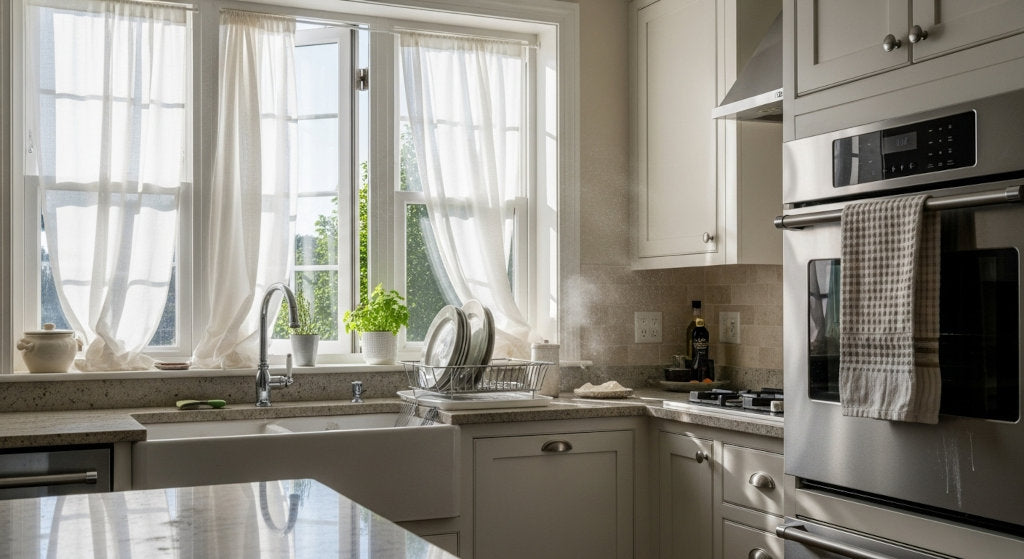Everyone’s done it. A forgotten skillet, overheated oil, or oven spill turns into a cloud of smoke, and suddenly your kitchen smells like a charred mess. Worse, that sharp, acrid odor doesn’t stay in the kitchen. It drifts through hallways, clings to curtains, and settles into fabrics and ceilings long after the source is gone.
Opening a window helps. So does cleaning the stove. But most of the time, the burnt-food scent stays behind. That’s because smoke particles from cooking mishaps are small, oily, and sticky. They embed into porous surfaces and keep releasing odor over time, especially in warm, still air.
Fortunately, there’s a way to clear the air and remove that smell completely using odor-neutralizing sprays and targeted fresh air routines.
Why Burnt Cooking Smell Is So Persistent
Smoke from burnt food or oil is chemically different from something like fireplace smoke. It contains grease particles, burnt sugar compounds, and moisture vapor—all of which cling to surfaces and linger in the air longer than you’d expect.
You may not see any residue, but the scent gets trapped in:
-
Kitchen cabinets and ceiling paint
-
Curtains, dish towels, and upholstered chairs
-
Air vents and range hoods that recirculate smoky air
-
Refrigerator seals and nearby pantry items
Traditional air fresheners only layer scent on top. They don’t solve the problem. That’s why odor-neutralizing sprays designed for smoke and grease particles are the most effective solution.
What to Use for Smoke Odor Removal
Not all sprays are created equal. Look for a product that doesn’t rely on masking fragrance. The best sprays contain neutralizing compounds that bond with odor molecules and help eliminate them from the air and surrounding surfaces.
Avoid anything heavily perfumed. A strong floral or fruit scent will mix with the burnt smell and create an even more unpleasant result. What you need is odor removal, not cover-up.
Where to Spray After a Burnt Cooking Incident
Once the smoke clears, it’s time to neutralize what’s left behind. One fine-mist odor spray can go a long way if used in the right spots:
-
In the air and around the cooking area
-
On nearby curtains, kitchen towels, or fabric dining chairs
-
Across ceilings and upper walls where warm smoke rose
-
On vents or filters that may have pulled smoke inside
-
Under cabinets and around hoods that trap grease vapor
Always mist lightly, because over-saturating won’t make the spray more effective. Allow each surface to dry fully. If needed, reapply after a few hours to reach deeper odors embedded in fabric or porous materials.
Ventilation Still Matters
Even after using an odor-neutralizing spray, you’ll get better results when you combine it with proper airflow. Smoke particles often linger in stagnant air. Moving that air out helps release trapped molecules and keeps the space from smelling stale.

Use these strategies to boost air circulation:
-
Turn on your range hood fan and leave it running for 20 minutes
-
Open windows at opposite ends of the room to create a cross-breeze
-
Use a small floor fan to push air toward an exit point
-
Leave doors open to encourage airflow through hallways
If the weather allows, ventilate for at least 30 minutes. This process lets neutralized particles exit the space instead of settling back onto surfaces.
Don’t Forget Fabrics and Soft Surfaces
Burnt cooking odors love to hide in soft materials. Fabric window treatments, kitchen linens, and even nearby coats can soak up the scent. Odor-eliminating spray works well on most fabrics, but always test a small area first.
You may also want to wash curtains or linens that were exposed to direct smoke. Laundering with baking soda or vinegar can assist with deep odor removal. For items that can’t be washed easily, a second round of spray and fresh air may be enough to restore freshness.
What About Ceilings and High Surfaces?
This is often overlooked, but it’s a common reason smoke smells return. Heat rises, and so does smoke. Ceilings, upper cabinets, and tops of shelves often absorb more smoke than lower areas. They may not look dirty, but they can trap particles that keep releasing odor over time.
Use a microfiber cloth and a gentle cleaner on reachable surfaces. Then, mist a neutralizing spray into the upper airspace and allow it to settle. Repeating this step every day or two until the scent fully fades helps prevent a slow return of odor.
Keep a Kit Ready for Future Mishaps
Cooking accidents happen fast. The sooner you act, the less chance smoke has to embed deeply into your space. Having a few tools on hand makes a big difference:
-
A non-perfumed odor-neutralizing spray designed for kitchen or smoke odor
-
A clean microfiber cloth or mop for ceilings and walls
-
A small fan for post-incident ventilation
-
Optional: a box of baking soda or vinegar for fabric pre-treatment
With this kit nearby, you’ll be ready to take action the next time the toast gets a little too dark or a skillet overheats. Quick cleanup, fresh air, and the right product will save you hours of lingering scent later.
Freshness After the Flame
A burned dinner doesn’t have to ruin the whole evening. With a smart cleanup strategy and an odor-removing spray that targets the actual source, you can reclaim your space and restore clean, breathable air.
Don’t settle for masking a problem that can be removed. A trusted odor-eliminating company’s spray, used with intention, clears the air and brings back the calm, clean kitchen you started with.








